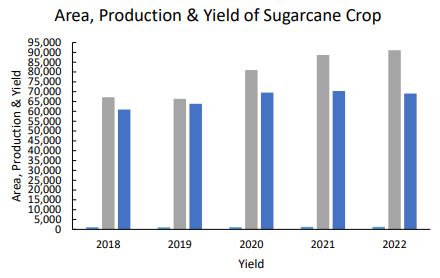Unraveling Pakistan's Agricultural Tapestry: Dynamics of Major Crop Production and Economic Implications
Keywords:
Threats To Sustainability, Food Security, Crop Production, GDP ContributionAbstract
This study presents a comprehensive analysis of major crop dynamics in Pakistan, focusing on cotton, sugarcane, rice, maize, and wheat, utilizing data from the Pakistan Bureau of Statistics. Despite the significant contributions of the agricultural sector to Pakistan's economy, challenges such as population growth, decreasing per capita land availability, and fluctuations in crop production pose threats to sustainability. Through descriptive statistics and regression analysis, the study explores the relationships between crop production, GDP contribution, and agricultural value added. Cotton, sugarcane, rice, maize, and wheat collectively contribute to economic growth and food security, but their correlations with agricultural gain vary. While cotton and sugarcane exhibit low correlations, rice shows an inverse relationship, maize demonstrates a strong positive correlation, and wheat displays an insignificant correlation with agricultural gain. These findings underscore the complexity of Pakistan's agricultural landscape, emphasizing the need for multifaceted strategies to enhance productivity, profitability, and sustainability in the sector.
References
P. K. Ghosh, “Growth, yield, competition and economics of groundnut/cereal fodder intercropping systems in the semi-arid tropics of India,” F. Crop. Res., vol. 88, no. 2–3, pp. 227–237, Aug. 2004, doi: 10.1016/j.fcr.2004.01.015.
“Major Crops Forecasting Area, Production and Yield Evidence from Agriculture Sector of Pakistan.” Accessed: Feb. 16, 2024. [Online]. Available: https://researcherslinks.com/current-issues/Major-Crops-Forecasting-Area-Production-and-Yield-Evidence-from-Agriculture-Sector-of-Pakistan/14/1/714/html
Y. Huang, Y. Lan, S. J. Thomson, A. Fang, W. C. Hoffmann, and R. E. Lacey, “Development of soft computing and applications in agricultural and biological engineering,” Comput. Electron. Agric., vol. 71, no. 2, pp. 107–127, May 2010, doi: 10.1016/J.COMPAG.2010.01.001.
A. A. Chandio, J. Yuansheng, and H. Magsi, “Agricultural Sub-Sectors Performance: An Analysis of Sector-Wise Share in Agriculture GDP of Pakistan,” Int. J. Econ. Financ., vol. 8, no. 2, p. 156, Jan. 2016, doi: 10.5539/IJEF.V8N2P156.
D. A. Dickey and W. A. Fuller, “Distribution of the Estimators for Autoregressive Time Series With a Unit Root,” J. Am. Stat. Assoc., vol. 74, no. 366, pp. 427–431, 1979, doi: 10.1080/01621459.1979.10482531.
S. A. Imam, A. H. M. Delwar Hossain, L. C. Sikka, and D. J. Midmore, “Agronomic management of potato/sugarcane intercropping and its economic implications,” F. Crop. Res., vol. 25, no. 1–2, pp. 111–122, 1990, doi: 10.1016/0378-4290(90)90076-N.
V. K. Boken, “Forecasting spring wheat yield using time series analysis: A case study for the Canadian prairies,” Agron. J., vol. 92, no. 6, pp. 1047–1053, 2000, doi: 10.2134/AGRONJ2000.9261047X.
“View of Agriculture Sector in Pakistan (A Historic Analysis).” Accessed: Feb. 22, 2024. [Online]. Available: https://journal.50sea.com/index.php/IJASD/article/view/428/509
R. Chen, J. Huang, and F. Qiao, “Farmers’ knowledge on pest management and pesticide use in Bt cotton production in china,” China Econ. Rev., vol. 27, pp. 15–24, 2013, doi: 10.1016/j.chieco.2013.07.004.
M. Kaleem Abbasi, M. M. Tahir, A. Sadiq, M. Iqbal, and M. Zafar, “Yield and nitrogen use efficiency of rainfed maize response to splitting and nitrogen rates in Kashmir, Pakistan,” Agron. J., vol. 104, no. 2, pp. 448–457, Mar. 2012, doi: 10.2134/AGRONJ2011.0267.
M. A. Kahlown, A. Raoof, M. Zubair, and W. D. Kemper, “Water use efficiency and economic feasibility of growing rice and wheat with sprinkler irrigation in the Indus Basin of Pakistan,” Agric. Water Manag., vol. 87, no. 3, pp. 292–298, Feb. 2007, doi: 10.1016/j.agwat.2006.07.011.
C. A. O. Midega et al., “Farmers’ perceptions of cotton pests and their management in western Kenya,” Crop Prot., vol. 42, pp. 193–201, Dec. 2012, doi: 10.1016/j.cropro.2012.07.010.
B. Azeem, K. Kushaari, Z. B. Man, A. Basit, and T. H. Thanh, “Review on materials & methods to produce controlled release coated urea fertilizer,” J. Control. Release, vol. 181, no. 1, pp. 11–21, May 2014, doi: 10.1016/J.JCONREL.2014.02.020.
“Economic perspectives of major field crops of Pakistan: An empirical study - ScienceDirect.” Accessed: Feb. 18, 2024. [Online]. Available: https://www.sciencedirect.com/science/article/pii/S2405883116300569
N. K. Fageria and V. C. Baligar, “Enhancing Nitrogen Use Efficiency in Crop Plants,” Adv. Agron., vol. 88, pp. 97–185, 2005, doi: 10.1016/S0065-2113(05)88004-6.
M. Khan and C. A. Damalas, “Factors preventing the adoption of alternatives to chemical pest control among Pakistani cotton farmers,” Int. J. Pest Manag., vol. 61, no. 1, pp. 9–16, Jan. 2015, doi: 10.1080/09670874.2014.984257.
A. Rehman et al., “Economic perspectives of major field crops of Pakistan: An empirical study,” Pacific Sci. Rev. B Humanit. Soc. Sci., vol. 1, no. 3, pp. 145–158, Nov. 2015, doi: 10.1016/J.PSRB.2016.09.002.
M. Arshad et al., “Farmers’ perceptions of insect pests and pest management practices in Bt cotton in the Punjab, Pakistan,” Int. J. Pest Manag., vol. 55, no. 1, pp. 1–10, 2009, doi: 10.1080/09670870802419628.
R. S. Tsay, “Analysis of Financial Time Series,” Aug. 2005, doi: 10.1002/0471746193.




